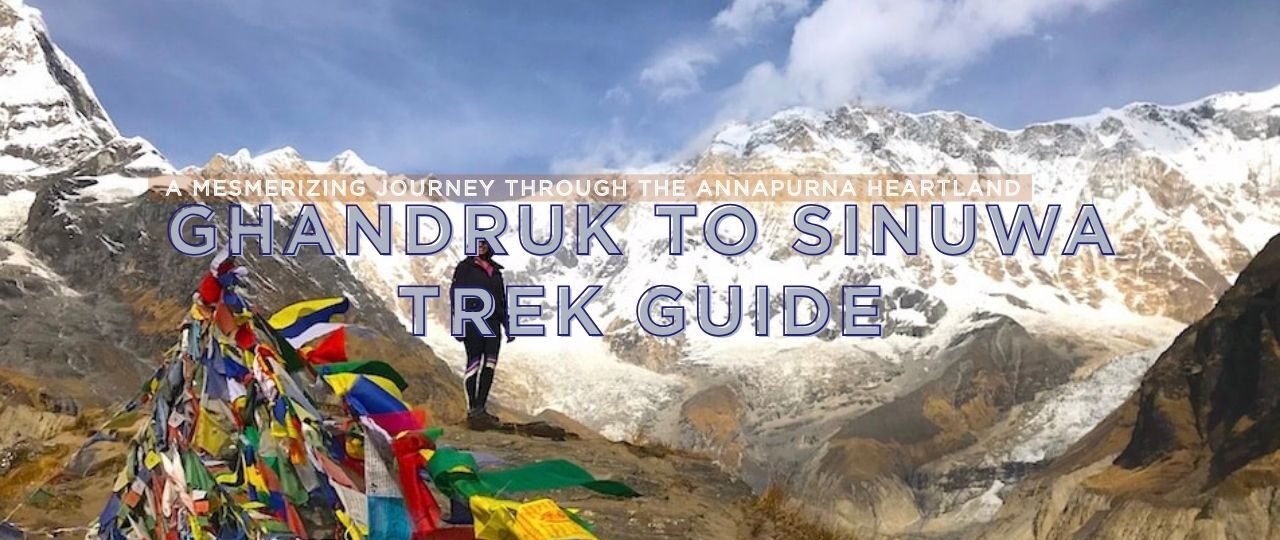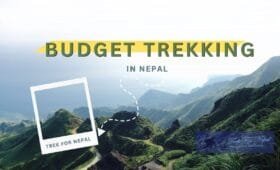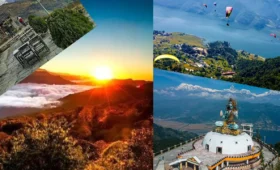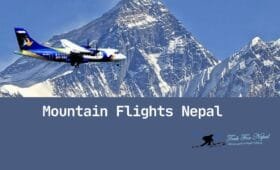The Ghandruk to Sinuwa Trek is a captivating short route in Nepal’s Annapurna region, offering a perfect slice of Himalayan beauty. Traversing lush forests, terraced hillsides, and ethnic Gurung villages, the trek ultimately leads to Sinuwa—a gateway settlement often visited en route to the famous Annapurna Base Camp Trek via Ghandruk. For many travelers, venturing from Ghandruk Village, Nepal, to Sinuwa reveals a culturally rich, moderate-difficulty trek that seamlessly blends scenic wonders and local hospitality.
In this detailed Ghandruk to Sinuwa Trek guide, we will explore every dimension of the Trek: from the recommended itinerary, distance, difficulty, and best times to go to essential tips on permits, weather, and philanthropic travel opportunities with Volunteers Initiative Nepal (ViN). Whether you aim to continue further into the Annapurna Sanctuary or savor this shorter route, the Ghandruk to Sinuwa Trek offers an immersive Nepalese adventure that’s both accessible and unforgettable.
Introduction
1. Introduction: Why the Ghandruk to Sinuwa Trek?
Ghandruk, located at an elevation of ~1,940 meters, is one of Nepal’s most charming Gurung settlements. Dotted with stone-roofed houses and labyrinthine alleyways, Ghandruk Village Nepal is renowned for its panoramic vistas of Annapurna South, Hiunchuli, and Machhapuchhre (Fishtail). Meanwhile, Sinuwa rests higher up the Modi Khola valley (~2,360m), serving as a crucial stop for trekkers heading deeper toward Annapurna Base Camp.
Ghandruk to Sinuwa Trek merges moderate altitudes with dramatic terrain and an unmatched cultural experience. While the route is short, it offers steep climbs, waterfalls, and dense rhododendron forests. Trekkers relish the Himalayan landscapes, a daily dose of local cuisines, and warm interactions with the mountain communities.
Statistic: According to the Annapurna Conservation Area Project (ACAP), over 150,000 tourists visit Annapurna trekking routes yearly, but a fraction choose to explore the direct path from Ghandruk to Sinuwa Trek. This smaller footfall ensures a more tranquil, culturally immersive experience. Meanwhile, local teahouse owners echo how visitors revitalize rural livelihoods through tourism.
“I found the Ghandruk to Sinuwa Trek surprisingly versatile—one day, I was marveling at Ghandruk’s traditional houses, and the next day, I was climbing through lush forests with glimpses of Machhapuchhre. It’s perfect if you want to sample the Annapurna region in a shorter timeframe,”
says Li Wen, a 28-year-old traveler from Singapore.
Highlights
2. Cultural & Natural Highlights in the Region
2.1 Ghandruk Village Nepal
Perched on terraced slopes, Ghandruk is often praised for its vistas of Annapurna South (7,219m) and Machhapuchhre (6,993m). The village’s stone walls, narrow pathways, and handwoven crafts reflect the Gurung community’s heritage. Many travelers also visit the Gurung Museum, gleaning insights into local traditions and attire.
2.2 Diverse Ecozones
As you move from Ghandruk to Sinuwa Trek Route, you transition from farmland to subtropical forests, eventually encountering bamboo groves near Sinuwa. The route’s ecosystem fosters an array of birdlife, including Himalayan bulbuls and pheasants, while monkeys can occasionally be spotted swinging across the canopy. The Ghandruk to Sinuwa Trek Distance is modest (~12–14 km), but the dramatic environmental shifts keep it lively.
2.3 Sinuwa Settlement
Sinuwa stands at ~2,360m, typically a quiet hamlet overshadowed by higher stops (Deurali, Machhapuchhre Base Camp) on the journey to Annapurna Base Camp. Nonetheless, it features a cluster of teahouses set amid scenic ridges. Trekking from Ghandruk to Sinuwa may include crossing Chhomrong village (~2,170m), recognized for its vantage toward the Annapurna Sanctuary.
Trek Itinerary
3. Ghandruk to Sinuwa Trek Itinerary
The Ghandruk to Sinuwa Trek Itinerary can be completed in 2–3 days, though some combine it into a longer Annapurna Base Camp route. Below is a representative 3-day plan starting from Pokhara:
Day 1: Drive Pokhara → Kimche, Trek to Ghandruk (~1,940m)
~2 hours by jeep/bus to Kimche, then a ~1–2 hour hike to Ghandruk. Overnight in a local teahouse. Explore Ghandruk’s museum or vantage points.
Day 2: Ghandruk → Chhomrong (~2,170m)
~5–6 hours of trekking. The trail descends to a river, then ascends to Chhomrong. Teahouse lodging. Panoramic glimpses of Annapurna South and Machhapuchhre.
Day 3: Chhomrong → Sinuwa (~2,360m)
~3–4 hours, crossing the Chhomrong Khola over a suspension bridge, then ascending steeply to Sinuwa. You can push on if you continue deeper (to Himalaya, Deurali, etc.). Or conclude your official trek in Sinuwa, returning to Chhomrong the following day.
The duration of the Ghandruk to Sinuwa Trek Trek can be shortened or extended. Some adventurous hikers compress Ghandruk–Chhomrong–Sinuwa in a single day (~7–8 hours), but that’s physically demanding. Meanwhile, if you aim for the entire Annapurna Base Camp Trek via Ghandruk, you’ll proceed beyond Sinuwa for an extra 4–5 days to the Sanctuary.
Trek Distance
4. The Ghandruk to Sinuwa Trek Distance
The direct Ghandruk to Sinuwa Trek Distance is ~12–14 km if you measure from Ghandruk to Sinuwa along standard footpaths. However, daily segments can vary:
- Ghandruk → Chhomrong: ~8–9 km, multiple descents and ascents, ~5–6 hours.
- Chhomrong → Sinuwa: ~4–5 km, ~3–4 hours, crossing 300–400m in net altitude gain.
Trekkers often appreciate the route’s moderate length. You’ll still climb ~500–800m daily, so prior hiking experience helps. The scenic vantage from each vantage is well worth the effort.
Trek Difficulty
5. Gauging Ghandruk to Sinuwa Trek Difficulty
Ghandruk to Sinuwa Trek Difficulty hovers around moderate. Key points:
- Altitude: Sinuwa sits ~2,360m, below the typical acute altitude sickness threshold (~3,000m+).
- Steep Climbs: The route toggles between valleys and ridges. Chhomrong’s upward steps can feel intense.
- Duration: ~2–3 days of trekking, each ~5–6 hours. It is manageable for novices with decent fitness.
- Weather: Rain or leeches hamper the route in monsoon, while winter might see chilly nights but is passable.
Most moderately fit individuals handle it fine, though trekking poles can help with descents. If one continues deeper into Annapurna Base Camp, the difficulty intensifies as the altitude surpasses 3,000m. But from Ghandruk to Sinuwa, specifically, the route remains an excellent mid-level trek.
Trek Mapping
6. Considering the Ghandruk to Sinuwa Trek Map
A Ghandruk to Sinuwa Trek Map typically outlines:
- Kimche (~1,640m): Bus/jeep drop-off.
- Ghandruk (~1,940m): A main Gurung village.
- Komrong Danda (~2,200m) or alternative paths toward Jhinu Danda (~1,780m).
- Chhomrong (~2,170m): Notable vantage point, multiple teahouses, checkpoint for ACAP.
- Sinuwa (~2,360m): The turning point or onward route to Dovan, Deurali, MBC, and ABC.
Ghandruk to Sinuwa Trek Route might also loop near Jhinu Danda (famous for hot springs), but the standard route crosses Komrong Danda. Checking a local map or Sinuwa trekking guide ensures you pick the best path, especially if exploring side villages.
Best Timing
7. The Best Timing: Ghandruk to Sinuwa Trek Best Time
Ghandruk to Sinuwa Trek Weather follows typical Annapurna patterns:
- Autumn (Sept–Nov): Crisp skies, ~15–20°C in lower altitudes, sub-zero nights above 3,000m. Minimal rainfall and excellent mountain clarity.
- Spring (Mar-May): Rhododendron blooms in forests, moderate daytime temps, occasional afternoon showers.
- Winter (Dec–Feb): Fewer trekkers, mild days ~10–15°C near Ghandruk, chilly nights ~0°C. The route remains open, though ABC might see heavy snow.
- Monsoon (Jun–Aug): Heavy rain, leeches, muddy trails, frequent cloud cover, though farmland is lush and vibrant.
Hence, the Ghandruk to Sinuwa Trek Best Time is typically autumn or spring for stable conditions and scenic mountain vistas. Winter suits those craving fewer crowds and can handle cooler nights. Monsoons are feasible but hamper visibility and can cause trail slipperiness.
Trek Cost
8. Budget Breakdown: Ghandruk to Sinuwa Trek Cost
Ghandruk to Sinuwa Trek Cost is relatively low among Annapurna routes, given the short duration and moderate altitude:
- Transport
- Pokhara to Kimche bus/jeep ~USD 3–10, or private jeep ~USD 30–60 if shared.
- Accommodation & Food
- Teahouses: ~USD 3–6 per room nightly. Some might charge extra for hot showers (~USD 2–3).
- Meals: ~USD 20–25 daily for dal bhat, noodles, and Western items.
- Permits
- Annapurna Conservation Area Permit (ACAP): ~USD 30.
- TIMS Card (~USD 10–20).
- Guide/Porter
- A Sinuwa Trekking Guide is optional (~USD 25–30/day). A porter (~USD 15–25/day).
- Misc
- Charging (~USD 1–2), Wi-Fi (~USD 2–3) in some teahouses.
Hence, for a 3–4 day journey, budget ~USD 120–200 if going minimal, plus transport. A Ghandruk to Sinuwa Trek Package might run ~USD 200–400, depending on group size, comfort level, and if continuing to ABC.
Trek Permits
9. Permits, Rules, & Checkpoints: Ghandruk to Sinuwa Trek Permits
While the route is short, you still trek within the Annapurna region. Must-haves:
- Annapurna Conservation Area Permit (ACAP): ~USD 30.
- TIMS Card: ~USD 10–20.
- Local Checkpoints
- Show permits in Ghandruk or near Chhomrong. Keep passport/visa copies.
No special “Ghandruk to Sinuwa Trek Permits” beyond ACAP/TIMS are required if you do not cross restricted zones. If heading deeper into the Sanctuary, keep receipts for ACAP checks near Sinuwa or Himalaya.
Trekking Guide
10. Hiring a Sinuwa Trekking Guide
A Sinuwa Trekking Guide is not mandatory for Ghandruk to Sinuwa, but helpful if:
- Time Constraints: Guides help streamline logistics if you have limited days.
- Cultural Insights: They interpret local customs, connect you with families, and ensure you choose the best teahouses.
- Navigation: The route is mostly straightforward. However, alternative paths or side trips might confuse novices.
- Safety: If you’re new to altitude or concerned about potential injuries, having professional assistance is reassuring.
Rates ~USD 25–30/day. Some prefer a porter (~USD 15–25/day) if carrying heavy cameras or gear. If continuing to ABC, a guide ensures safe passage across higher altitudes.
FAQs
11. The Seven Most Frequently Asked Questions
What is the Ghandruk to Sinuwa Trek Distance?
~12–14 km total. Day 1: Ghandruk–Chhomrong ~8–9 km. Day 2: Chhomrong–Sinuwa ~4–5 km.
How difficult is the Ghandruk to Sinuwa Trek Difficulty?
Moderate. Expect several steep ascents/descents. Suitable for novices with decent fitness.
What is the duration of the Ghandruk to Sinuwa Trek?
Commonly, 2–3 days. Ghandruk to Chhomrong (~5–6 hours), then Chhomrong to Sinuwa (~3–4 hours).
How much does the Ghandruk to Sinuwa Trek Cost?
~USD 120–200 for a minimal approach. ~USD 200–400 if booking a small package with a guide/porter.
Which is the best time for this route?
Autumn (Sept–Nov) or spring (March) is suitable for stable weather and clear views. Winter is fine, but on cooler nights, the monsoons bring heavy rain.
Do I need a Ghandruk to Sinuwa Trek Permit?
The Annapurna Conservation Area Permit (~USD 30) and TIMS (~USD 10–20) suffice; no special restricted permit is required.
Can I continue to Annapurna Base Camp from Sinuwa?
Absolutely. Many do the Annapurna Base Camp Trek via Ghandruk after reaching Sinuwa. That extension adds ~4–5 days deeper into the Sanctuary.
Accommodation
12. Lodging & Food: Ghandruk to Sinuwa Trek Accommodation
Ghandruk to Sinuwa Trek Accommodation revolves around teahouses:
- Ghandruk: Dozens of teahouses, some more modern with Wi-Fi, hot showers, and private bathrooms. Typically ~USD 3–6 per night.
- Chhomrong: A major stop with a wide variety of lodgings. Expect standard teahouse rooms and communal dining.
- SinuwThere is f: Fewer teahouses, especially if you continue to ABThere are u. Usually, there are 2–4 lodges. They are basic but comfortable.
Meals revolve around Nepali staples—dal bhat, noodles, momos, roti. Western items appear but cost more. Winter might see fewer teahouses open, so confirm in Ghandruk or Chhomrong if traveling off-peak.
Trek Weather
13. Ghandruk to Sinuwa Trek Weather & Seasonal Patterns
Ghandruk to Sinuwa Trek Weather typically:
- Autumn (Sept–Nov): Crisp, stable, daytime ~15–20°C near Ghandruk, sub-zero nights above 3,000m. Minia and l rainfall, excellent mountain visibility.
- Spring (Mar-May): Warmer days, ~15–25°C in low hills, occasional storms, vibrant rhododendrons. Clear mornings, hazy afternoons sometimes.
- Winter (Dec–Feb): Milder days (~10–15°C in Ghandruk), nights near or below 0°C around Sinuwa. Fewer trekkers, but the route remains open.
- Monsoon (Jun–Aug): High humidity, frequent storms, muddy trails, limited panoramic views. It is lush farmland, though.
The route remains accessible year-round, though autumn and spring remain the best windows for stable trekking. Winter suits those seeking fewer crowds and can handle chillier evenings.
Trek Tips
14. Pro Tips: Ghandruk to Sinuwa Trek Tips
14.1 Physical Preparation
- Cardio: Regular walking, jogging, or cycling for a few weeks prior.
- Pacing: The ascents can be steep, so use trekking poles for joint relief and step steadily.
14.2 Altitude Awareness
- Sinuwa (~2,360m) is modest, so the risk of altitude sickness is low, though you might sense mild breathlessness if you rush.
- If continuing to ABC, schedule acclimatization days above 3,000m.
14.3 Minimizing Environmental Footprint
- Carry Reusable Bottles: Refill with boiled/filtered water from teahouses to avoid plastic.
- Bag Out Trash: Disposal systems are essential.
- Respect: Seek permission before photographing locals, and remain mindful of local customs.
14.4 Potential Route Extensions
- Annapurna Base Camp: Sinuwa is an official stepping stone toward the Sanctuary. Add ~4–5 days from Sinuwa to reach ABC (~4,130m) and back.
- Jhinu Hot Springs: Some travelers detour near Chhomrong to soak in riverside hot springs.
Testimonials
Real-Life Testimonials & Ghandruk to Sinuwa Trek Reviews
Many Ghandruk to Sinuwa Trek Reviews highlight the route’s perfect synergy of moderate challenge, vibrant vistas, and deep cultural immersion:
Arjun’s Perspective:
“I’m Nepalese, but the Ghandruk to Sinuwa Trek always charms me. Every time I bring foreign friends, they’re surprised at how quickly we enter mountainous terrain from farmland. By Sinuwa, we’re perched so close to the high peaks, it feels magical.”
Linda’s Experience:
“We just wanted a 3-day mini-trek from Ghandruk to Sinuwa. The route was short yet steep in spots, but the teahouses were cozy, and we loved meeting friendly locals. Next time, we’ll push on to ABC!”
Many find the trek a stepping-stone toward advanced Annapurna routes, praising the possibility of further expansions.
Conclusion
From Ghandruk’s cultural heartland to Sinuwa’s vantage above the Modi Khola gorge, the Ghandruk to Sinuwa Trek merges local heritage, moderate altitudes, and enthralling Himalayan views. It’s a shorter approach than the entire Annapurna circuit but still captures the essence of Annapurna Trekking Routes—like farmland, rhododendron forests, and glimpses of snow-clad summits. Whether you’re a novice or a returning trekker, Ghandruk to Sinuwa Trek offers a balanced taste of Nepal’s famed trails.
Double Your Impact with Volunteers Initiative Nepal
Volunteers Initiative Nepal (ViN) organizes charity trekking and travel tours, funneling all proceeds to community empowerment. By joining the Ghandruk to Sinuwa Trek with ViN, you create a double impact—enriching your own Himalayan adventure while uplifting rural families:
Share: Encourage your networks—friends, family, social media—to adopt philanthropic trekking, broadening beneficial transformations across Nepal’s mountain communities.
- Volunteer: Contribute your time or skills to local education, environmental, or health initiatives around Ghandruk or Sinuwa.
- Intern: Align academic or professional goals with genuine field research or community-based projects.
- Donate: Even modest funds accelerate essential improvements in remote schooling, sanitation, or cultural preservation.
Namaste—and may your footprints from Ghandruk to Sinuwa unify personal discovery with communal uplift, forging a future where adventure travelers and local communities flourish together.
Additional Info
Extended Info: Practical Guidance & Final Inspiration
To finalize your approach, consider:
1. Seasonal Overviews
- Autumn (Sept–Nov): Crisp, ~15–20°C in Ghandruk, nearly 5–10°C in Sinuwa nights. Minimal rain, superb mountain clarity.
- Spring (Mar-May): Blooming forests, comfortable temps. In late April, we can see afternoon showers.
- Winter (Dec–Feb): Quieter route, nights near 0°C in Sinuwa. The path remains open.
- Monsoon (Jun–Aug): Expect heavy rainfall, cloudy vistas, and leeches in the forest: lush farmland but slippery trails.
2. If You Have More Days
- Hot Spring Detour: From Chhomrong, descend to Jhinu Danda for riverside hot springs. The next day, rejoin the Sinuwa path.
- ABC Extension: If you crave more alpine experiences, travel from Sinuwa to Deurali and Annapurna Base Camp. Add 4–5 days.
3. Overcoming Minor Obstacles
- Steep Steps: Use trekking poles and pace yourself. The descents can be as challenging as ascents.
- Altitude: Sinuwa’s ~2,360m is safe from significant AMS risk, but if continuing to ABC, schedule acclimatization near Himalaya (~2,920m) or Deurali (~3,230m).
- Crowds: Autumn and spring can see moderate visitors—book teahouse rooms by mid-afternoon.
4. Post-Trek Opportunities
- Pokhara: Return for a well-deserved Lakeside relaxation or paragliding.
- Volunteering: Join a local project in the Ghandruk area or with ViN’s broader initiatives across Nepal.
Your short Himalayan adventure transcends typical tourism by merging the Ghandruk to Sinuwa Trek Route with philanthropic synergy. The route’s blend of moderate climbs, vibrant local life, and spectacular vantage points ensures each day resonates with authenticity. Let your trek help shape a better tomorrow for the communities you pass—transforming ephemeral footsteps into a lasting legacy.




